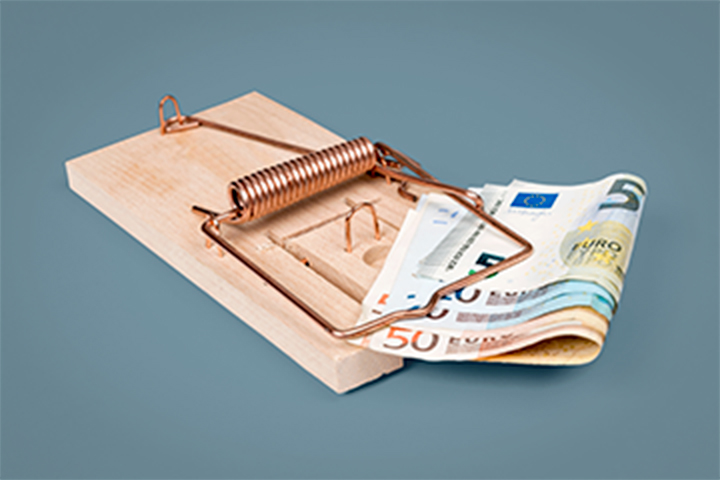Did you just purchase shares? Why you should immediately set a stop-loss

Keytrade Bank
keytradebank.be
March 08, 2024
(updated December 03, 2024)
6 minutes to read
Investors hate losses. Amos Tversky and Nobel Prize Winner Daniel Kahneman even calculated how much more painful it is to lose than to win. According to them, the negative emotional impact of a loss is, on average, twice as great as the positive impact of an equally large profit. It is nicer to pocket a profit than to swallow a loss, but the two are not symmetrical. Feels familiar, doesn't it?
One of the skills of investing is to learn how to sell at a loss. This is very difficult for most investors. When a share performs less well than expected – especially if you are really convinced it has potential for growth – then the temptation to hang on to it is very strong. But as you wait, 20% in the red can turn into 30%. 30% may become 40%. And a 40% loss may end up being 50% by the time you finally pull the trigger.
Waiting and hanging on is a major risk, but not the only one. While we are staring a growing loss in the face, we are also tempted to take bigger risks to offset the loss. Risks we might not otherwise take.
Simple and brilliant: the stop-loss order
So no matter how much we want to invest (and think we are investing) rationally: our investment decisions are always coloured one way or another by our emotions. That’s why it’s a good idea to not rely solely on your willpower to close out a loss-making position in good time. Thanks to a very simple and useful mechanism, you can do so at the right time and without delay. This mechanism is called the stop-loss.
A stop-loss is an order you place to sell a share as soon as it falls to a certain price. A stop-loss is designed to limit your losses on a share. For example, if you place a stop-loss order for 20% below the price at which you bought the share, you limit your loss to 20%.
Even if you are convinced that a share can only rise, it is always a very good habit to set a stop-loss immediately on each purchase. By doing so, you avoid making decisions based on emotions. At the same time, you avoid exposure to even greater losses and even more frustration.
Stop-loss versus review price
Using a stop-loss is normal practice for day traders and speculators, but less so for investors who hold long-term positions. Most such investors use "review prices" instead. If the share falls or rises to a certain price level, they then review their investment and decide (buy more, sell (part), or simply hold onto it). In theory, the use of a review price is useful. It forces the investor to think about the price trend of a share and to decide whether to take action or not. In practice, however, a review price gives an illusion of control rather than real control. Just doing nothing is often the result. Therefore, it is better to set up a stop-loss.
At what level should you set a stop-loss?
Recognise your mistakes in good time and take immediate action, was the mantra of notable investor Roy Rothschild Neuberger. He always set a stop-loss of 10%, indicating that this formed part of the basis of his success in investing. This 10% is probably too high a floor for many investors. A stop-loss between 10% and 30% maximum is recommended. If you are highly risk averse, better to choose a level around 10%. If you have "average" risk aversion, 20% is a good idea. If you are prepared to accept more risk, 30% is a good floor.
If a share is performing well you can, of course, replace the existing stop-loss with a new stop-loss at any time, with a higher floor. You can also do this automatically by opting for a trailing stop order. The stop price will always track the share price upwards, but the price will never move down (for an example, see below).
Disadvantages of stop-loss orders
The benefits of a stop-loss order are that you do not have to check daily how a share is performing, and that you disconnect your emotions. The main disadvantage is that a strong price fluctuation can trigger the stop-loss price, after which the price will rise again. The key is therefore to choose a stop-loss level that allows a share to fluctuate from day to day, while also avoiding as much downside risk as possible. Placing a stop-loss order of 5% on a share that has fluctuated 10% or more in one week in the past is therefore not the ideal strategy.
Another thing to keep in mind is that once you reach your stop price, your stop-loss order becomes a market order. The price at which you sell may therefore differ from the stop-loss price.
Difference between stop-loss, stop limit and trailing stop
Instead of a stop-loss, you can set a stop limit. A stop limit order, like a stop-loss order, is activated when a certain price is reached. However, a stop limit order changes to a limit order when the defined stop price is reached (and not to a market order as is the case for a stop-loss).
Stop-loss example
You have bought a share at EUR 100. You place a stop-loss sales order where you set EUR 95 as the stop-loss price. If the price falls to EUR 95, your order will be activated and executed at the market price.
Stop limit example
You have bought a share for EUR 100. You place a stop limit sell order, where you enter EUR 95 as the stop and EUR 93 as the limit. This means that when the price of the share falls to EUR 95, the order is activated and placed on the stock exchange with a sale price limit of EUR 93.
Trailing stop order example
If you place a trailing stop order, you do not have to set a limit or a stop price, but only a difference to the market price (expressed as a value, not as a percentage). You have bought a share for EUR 100. You place a trailing stop order to sell with a difference to the market price of 1. Your stop price is therefore EUR 99. As long as the share does not fall to EUR 99, it will not be sold. The trigger price tracks the share price upwards and always maintains a distance of 1 euro. The trigger price can never fall. If the price rises to a new level of, for example, EUR 103, the new, automatically adjusted stop price will be EUR 102.

